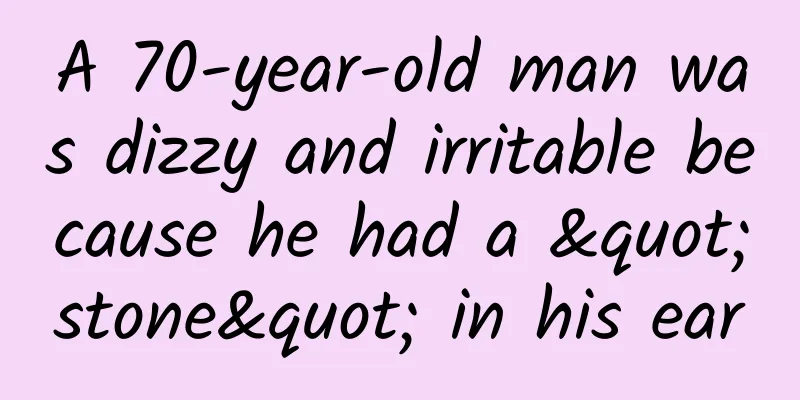A 70-year-old man was dizzy and irritable because he had a "stone" in his ear

|
Ms. Zhong, 75, felt dizzy when she got up, lay down, turned over, or turned her head. She came to the clinic of Professor Wu Dahua of the Department of Encephalopathy of the Affiliated Hospital of Hunan Institute of Traditional Chinese Medicine and was diagnosed with "otolithiasis". How can there be stones in the ears? Today, Professor Wu Dahua reminded that there are cystic plaques on the utricle and saccule of the inner ear, and there are many calcium carbonate crystals in the otolith membrane covering its surface. These are the "stones" in the ears, which can cause patients to feel strongly dizzy and lose balance. "Otolith disease" mostly affects middle-aged and elderly patients, but with the increasing number of people who are addicted to their phones, many young people also suffer from "Otolith disease". Recently, 75-year-old Ms. Zhong looked haggard, moved slowly, and had a stiff neck that she dared not move. She walked into the consulting room of Professor Wu Dahua of the Department of Encephalopathy of the Affiliated Hospital of Hunan Institute of Traditional Chinese Medicine like a robot. It turned out that in the past two months, the old man felt dizzy when he got up, lay down, turned over, turned his head, and had symptoms such as nausea, chest tightness, palpitations, irritability, etc. He took medicine and injections at the local hospital for half a month, but the symptoms became more and more serious. Professor Wu Dahua conducted a vertigo displacement test on the patient and confirmed that he had "otolithiasis". After repositioning treatment, the patient felt much more relaxed, the vertigo was significantly relieved, and he could move freely. After hearing that she had "otolithiasis", Ms. Zhong asked in confusion: How can there be stones in the ears? Professor Wu Dahua introduced that "otolithiasis" usually occurs in the deepest part of the human ear. There are cystic spots on the utricle and saccule of the inner ear. There are many calcium carbonate crystals in the otolith membrane covering its surface. These are the "stones" in our ears. These small otolith particles cannot be seen, touched or removed, and they fall into the semicircular canals (components of the inner ear). When the position of the head changes, the shaking stimulates the semicircular canals and produces an abnormal feeling of dizziness. Don't underestimate these fallen otoliths, which can not only cause patients to feel dizzy and lose balance, but also cause them to fall down instantly in severe cases. There are many factors that lead to the fall of otoliths, such as degeneration of the otolith membrane, metabolic abnormalities, trauma, inner ear ischemia, infection, etc. What are the main symptoms of "otolithiasis"? Professor Wu Dahua said that it can suddenly cause people to feel dizzy and nausea, vomiting and unstable standing. The disease has two characteristics: one is related to body position, often occurring when getting up, lying down, turning over, or turning the head; the other is that the dizziness is short-lived, lasting from a few seconds to tens of seconds. Medical data shows that "otolith disease" mostly affects middle-aged and elderly patients. Now, with the increase in the number of people who are addicted to their phones, working at desks for long periods of time, using mobile phones and computers with their heads down, frequently staying up late, having irregular work and rest schedules, and brain fatigue, many young people will also suffer from "otolith disease". Professor Wu Dahua reminds that after the onset of "otolithiasis", general drug efficacy is not ideal. The most effective treatment is to reposition the otoliths through the SRM-IV BPPV (otolithiasis) diagnosis and treatment system. After repositioning treatment, the patient felt much more relaxed, his vertigo was significantly relieved, and he was able to move freely. All pictures provided by the hospital When small otolith particles enter the semicircular canals, the position of the head changes, causing the semicircular canals to be stimulated and an abnormal feeling of dizziness will occur. |
<<: Why are there only humans on Earth? How many bird species are there on Earth?
Recommend
Does breast inversion necessarily mean breast cancer?
This is the 4800th article of Da Yi Xiao Hu Have ...
Why is it painful to give birth naturally in the rop position?
As we all know, fetal position is one of the prim...
Effect of Metronidazole Tablets in Treating Vaginitis
For women, gynecological diseases are a kind of d...
What can I see on ultrasound at 45 days of pregnancy?
I believe that mothers who have just learned that...
Will sitting for a long time make you ugly? I was so scared that I stood up quickly
Recently, there is a hot topic called #It turns o...
How much weight can you lose in 7 days during the golden period of weight loss after menstruation
Women's menstrual period refers to the physio...
Symptoms of premenopause at the age of 51
We all know that menopause means we are no longer...
What are the symptoms of gastroenteritis in women
Gastroenteritis is a common and frequently occurr...
What are the dangers of dyeing hair during menstruation?
Many young people have the habit of dyeing their ...
How to exercise at home for women
Many women cannot go out frequently due to their ...
What are the treatment principles for Trichomonas vaginitis?
The principle of treatment for Trichomonas vagini...
What to do if pregnant women have nasal allergies
Pregnant women are relatively weak in physical co...
Pregnant woman has dull pain in lower abdomen
Pregnant women experience dull pain in the lower ...
How to store mung bean sprouts overnight? How to eat bean sprouts
Mung bean sprouts are also called bean sprouts. T...
Can taking birth control pills during ovulation prevent pregnancy?
Taking emergency contraceptive pills during ovula...









